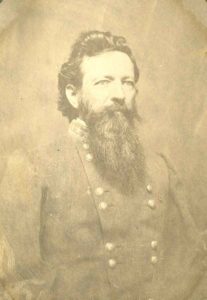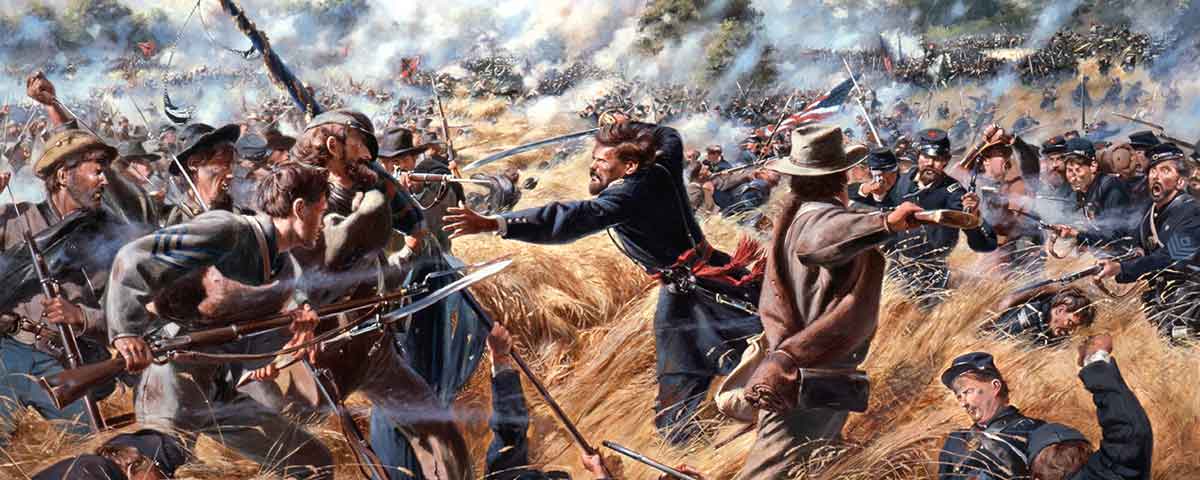Hand-to-hand fighting actually was rare at Gettysburg
As much as some popular histories and films of Gettysburg play it up, a visitor to the battlefield might imagine that most of the combat that took place there was hand to hand. The scene at the end of Pickett’s Charge in the movie Gettysburg is an example. The mix-up of blue and gray resembles a massive rugby scrum. The idea that hand-to-hand combat on any battlefield of the war was common is mostly myth, conjured up to sensationalize a terrible event that needs no embellishment. Even Pickett’s Charge saw very little true hand-to-hand fighting, although it is widely presumed that it was an ordinary occurrence at the height of the attack.
Hand-to-hand fighting is usually defined as combat with clubbed muskets and bayonets, sometimes even fists and rocks. Firing point blank might also fall into this category—the discharge of a weapon so close that it leaves powder burns on the killed or wounded.
Most infantry fighting at Gettysburg, however, occurred at ranges from 100 to 200 yards, though there were occasions when units engaged one another at longer and shorter ranges. During the bloody combat in the Herbst Woods on the afternoon of July 1, Brig. Gen. James Pettigrew’s Brigade and the Union Iron Brigade traded fire at 20–40 paces, with dreadful results. During a defense of the Rose Woods by Brig. Gen. Joseph Kershaw’s Brigade on July 2, Lt. Col. Franklin Gaillard of the 2nd South Carolina wrote: “It was so desperate I took two shots with my pistol at men scarcely thirty steps from me.” In neither of these actions, however, did the fighting come to hand to hand. One side always gave way before it could get that close.
When hand-to-hand fighting did occur, one of two factors almost always was present. First, the defending fire was so disorganized or weak that the enemy were able to rush across the deadliest ground—the last 30 to 40 yards—and close with the defender, or the attacker surprised the enemy from the rear or flank. Second, the defender believed he could fight off the attackers or he was trapped, and flight was either impossible or too fraught with danger to attempt escape. Both factors were present in the Wheatfield the afternoon of July 2. When Brig. Gen. William Wofford’s Georgians emerged from Rose Woods in the rear of Colonel Jacob Sweitzer’s 5th Corps brigade, Sweitzer made a desperate attempt to change front to face the onslaught. Running would have meant slaughter, so Sweitzer’s men attempted to fight off their attackers. Wofford said after the war that “more men were killed here with the bayonet than he had ever known before in the war.”

Wofford likely had seen few bayoneted in the war before Gettysburg. Nevertheless, we have good documentation that the combat here did involve the bayonet and was particularly vicious. According to Jacob Funk, the 62nd Pennsylvania’s color-bearer, “The battle know [sic] raged in all its fury as foe grappled with foe and the Bayonet was freely used.” Funk also recalled that when a Rebel officer demanded the Pennsylvanians surrender, “[O]ne of my company turned round and clubbing his musket brought the but[t] down on [his] hed[,] smashing him down on the spot.”
In a more famous encounter, when one Confederate tried to bear off the 4th Michigan’s flag, dropped when the color-bearer was shot, he was chased down by Colonel Harrison Jeffords, the 4th’s commander. Jeffords ran the Confederate through with his sword but was then impaled from behind by a bayonet wielded by a Rebel soldier, who in turn was shot at point blank range.
That incident might suggest that many others were bayoneted or run through with swords, but the truth was that Jeffords was the only man in his regiment to be bayoneted. This helps put Wofford’s statement in some perspective. There is little doubt he saw more men killed with the bayonet in the Wheatfield than he ever had before, but that number was still relatively small.
The part of the battle where probably more true hand-to-hand fighting occurred was not during Pickett’s Charge or in the Wheatfield but at East Cemetery Hill during the assault by Harry Hays’ and Isaac Avery’s brigades, of Jubal Early’s Division, on the evening of July 2. That attack was launched at dusk, and though Union artillery and infantry responded immediately, their fire was not accurate due to the falling light. This enabled Hays’ Louisianans to close with Federals at the base of the hill behind a stone wall. Recalled 1st Lt. Oscar Ladley of the 75th Ohio: “They came on us about dark yelling like demons with fixed bayonets. We opened on them when they were about 500 yards off but still they came their officers & colors in advance. We lay behind a stone wall and received them with our bayonets….A Rebel officer made at me with a revolver with his colors by his side. I had no pistol, nothing but my sword. Just as I was getting ready to strike him one of our boys run him through the body so saved me. There was a good many killed that way.”
One reason the fighting came down to hand to hand was that retreating uphill probably was riskier than sticking to the stone wall and fighting it out. Ladley noted how unusual this experience was compared to others he had. “I never saw such fighting in my life,” he would write. “It was a regular hand to hand fight.”
William Southerton, a 19-year-old private in Ladley’s regiment, left his position at the wall and retreated up the hill, where he witnessed more brutal hand-to-hand encounters around Union artillery positions. “Artillerists fought with ramrods, wielding them like ballbats,” he wrote, “So infuriated were the Tigers [the Louisianans of Hays’ Brigade] that they jabbed with their bayonets. Fought with rocks. A tall rebel shoved right at my elbow, a huge rock raised ready to dash it at Major Fox. I jabbed with my bayonet.” In moments, the fight was over and the Confederates retreated.
What nearly all the examples of hand-to-hand combat at Gettysburg have in common is that the writers inevitably note how extraordinary or rare they were. So though it did occur in various places during the battle, it was the exception to the rule those three days.
Scott Hartwig writes from the crossroads of Gettysburg.





